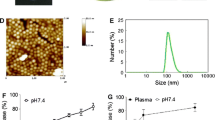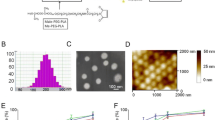Abstract
The purpose of this present study was to evaluate the antiangiogenic activity of sterically stabilized liposomes containing paclitaxel (SSL-PTX). The SSL-PTX was prepared by the thin-film method. The release of paclitaxel from SSL-PTX was analyzed using a dialysis method. The effect of SSL-PTX on endothelial cell proliferation and migration was investigated in vitro. The antitumor and antiangiogenic activity of SSL-PTX was evaluated in MDA-MB-231 tumor xenograft growth in BALB/c nude mice. The release of paclitaxel from SSL-PTX was 22% within 24 h. Our in vitro results indicated that SSL-PTX could effectively inhibit the endothelial cell proliferation and migration at a concentration-dependent manner. We also observed that metronomic SSL-PTX induced marked tumor growth inhibition in MDA-MB-231 xenograft model via the antiangiogenic mechanism, unlike that in paclitaxel injection (Taxol) formulated in Cremophor EL (CrEL). Overall, our results suggested that metronomic chemotherapy with low-dose, CrEL-free SSL-PTX should be feasible and effective.





Similar content being viewed by others
References
Frei 3rd E, Elias A, Wheeler C, Richardson P, Hryniuk W. The relationship between high-dose treatment and combination chemotherapy: the concept of summation dose intensity. Clin Cancer Res. 1998;4:2027–37.
Nieto Y. The verdict is not in yet. Analysis of the randomized trials of high-dose chemotherapy for breast cancer. Haematologica. 2003;88:201–11.
Kerbel RS, Kamen BA. The anti-angiogenic basis of metronomic chemotherapy. Nat Rev Cancer. 2004;4:423–36.
Laquente B, Viñals F, Germà JR. Metronomic chemotherapy: an antiangiogenic scheduling. Clin Transl Oncol. 2007;9:93–8.
Browder T, Butterfield CE, Kräling BM, Shi B, Marshall B, O’Reilly MS et al. Antiangiogenic scheduling of chemotherapy improves efficacy against experimental drug-resistant cancer. Cancer Res. 2000;60:1878–86.
Kamat AA, Kim TJ, Landen Jr CN, Lu C, Han LY, Lin YG et al. Metronomic chemotherapy enhances the efficacy of antivascular therapy in ovarian cancer. Cancer Res. 2007;67:281–8.
Belotti D, Vergani V, Drudis T, Borsotti P, Pitelli MR, Viale G et al. The microtubule-affecting drug paclitaxel has antiangiogenic activity. Clin Cancer Res. 1996;2:1843–9.
Ng SS, Figg WD, Sparreboom A. Taxane-mediated antiangiogenesis in vitro: influence of formulation vehicles and binding proteins. Cancer Res. 2004;64:821–4.
Byrne JD, Betancourt T, Brannon-Peppas L. Active targeting schemes for nanoparticle systems in cancer therapeutics. Adv Drug Deliv Rev. 2008;60:1615–26.
Straubinger RM, Arnold RD, Zhou R, Mazurchuk R, Slack JE. Antivascular and antitumor activities of liposome-associated drugs. Anticancer Res. 2004;24:397–404.
Sharma A, Sharma US, Straubinger RM. Paclitaxel-liposomes for intracavitary therapy of intraperitoneal P388 leukemia. Cancer Lett. 1996;107:265–72.
Huwyler J, Drewe J, Krähenbuhl S. Tumor targeting using liposomal antineoplastic drugs. Int J Nanomedicine. 2008;3:21–9.
Moghimi SM, Patel HM. Opsonophagocytosis of liposomes by peritoneal macrophages and bone marrow reticuloendothelial cells. Biochim Biophys Acta. 1992;1135:269–74.
Lasic DD. Doxorubicin in sterically stabilized liposomes. Nature. 1996;11(380):561–2.
Yuan F, Dellian M, Fukumura D, Leunig M, Berk DA, Torchilin VP et al. Vascular permeability in a human tumor xenograft: molecular size dependence and cutoff size. Cancer Res. 1995;55:3752–6.
Yang T, Cui FD, Choi MK, Cho JW, Chung SJ, Shim CK et al. Enhanced solubility and stability of PEGylated liposomal paclitaxel: in vitro and in vivo evaluation. Int J Pharm. 2007;338:317–26.
Yang T, Choi MK, Cui FD, Lee SJ, Chung SJ, Shim CK et al. Antitumor effect of paclitaxel-loaded PEGylated immunoliposomes against human breast cancer cells. Pharm Res. 2007;24:2402–11.
Crosasso P, Ceruti M, Brusa P, Arpicco S, Dosio F, Cattel L. Preparation, characterization and properties of sterically stabilized paclitaxel-containing liposomes. J Control Release. 2000;63:19–30.
Miele E, Spinelli GP, Miele E, Tomao F, Tomao S. Albumin-bound formulation of paclitaxel (Abraxane ABI-007) in the treatment of breast cancer. Int J Nanomedicine. 2009;4:99–105.
Stinchcombe TE. Nanoparticle albumin-bound paclitaxel: a novel Cremophor-EL free formulation of paclitaxel. Nanomedicine (Lond). 2007;2:415–23.
Desai N, Trieu V, Yao Z, Louie L, Ci S, Yang A et al. Increased antitumor activity, intratumor paclitaxel concentrations, and endothelial cell transport of Cremophor-free, albumin-bound paclitaxel, ABI-007, compared with Cremophor-based paclitaxel. Clin Cancer Res. 2006;12:1317–24.
Ng SS, Sparreboom A, Shaked Y, Lee C, Man S, Desai N et al. Influence of formulation vehicle on metronomic taxane chemotherapy: albumin-bound versus Cremophor EL-based paclitaxel. Clin Cancer Res. 2006;12:4331–8.
Ashton AW, Yokota R, John G, Zhao S, Suadicani SO, Spray DC et al. Inhibition of endothelial cell migration, intercellular communication, and vascular tube formation by thromboxane A(2). J Biol Chem. 1999;274:35562–70.
Vichai V, Kirtikara K. Sulforhodamine B colorimetric assay for cytotoxicity screening. Nat Protoc. 2006;1:1112–6.
Bijman MN, Van Nieuw Amerongen GP, Laurens N, van Hinsbergh VW, Boven E. Microtubule-targeting agents inhibit angiogenesis at subtoxic concentrations, a process associated with inhibition of Rac1 and Cdc42 activity and changes in the endothelial cytoskeleton. Mol Cancer Ther. 2006;5:2348–57.
Liu XR, Wu KC, Huang Y, Sun JB, Ke XY, Wang JC et al. In vitro and in vivo studies on plasma-to-blood ratio of paclitaxel in human, rabbit and rat blood fractions. Biol Pharm Bull. 2008;31:1215–20.
Aapro MS, Von Minckwitzb G. Molecular basis for the development of novel taxanes in the treatment of metastatic breast cancer. EJC Supplements. 2008;6:3–11.
Kunstfeld R, Wickenhauser G, Michaelis U, Teifel M, Umek W, Naujoks K et al. Paclitaxel encapsulated in cationic liposomes diminishes tumor angiogenesis and melanoma growth in a “humanized” SCID mouse model. J Invest Dermatol. 2003;120:476–82.
Schmitt-Sody M, Strieth S, Krasnici S, Sauer B, Schulze B, Teifel M et al. Neovascular targeting therapy: paclitaxel encapsulated in cationic liposomes improves antitumoral efficacy. Clin Cancer Res. 2003;9:2335–41.
Strieth S, Eichhorn ME, Sauer B, Schulze B, Teifel M, Michaelis U et al. Neovascular targeting chemotherapy: encapsulation of paclitaxel in cationic liposomes impairs functional tumor microvasculature. Int J Cancer. 2004;110:117–24.
Strieth S, Nussbaum CF, Eichhorn ME, Fuhrmann M, Teifel M, Michaelis U et al. Tumor-selective vessel occlusions by platelets after vascular targeting chemotherapy using paclitaxel encapsulated in cationic liposomes. Int J Cancer. 2008;122:452–60.
Strieth S, Eichhorn ME, Werner A, Sauer B, Teifel M, Michaelis U et al. Paclitaxel encapsulated in cationic liposomes increases tumor microvessel leakiness and improves therapeutic efficacy in combination with Cisplatin. Clin Cancer Res. 2008;14:4603–11.
Bode C, Trojan L, Weiss C, Kraenzlin B, Michaelis U, Teifel M et al. Paclitaxel encapsulated in cationic liposomes: a new option for neovascular targeting for the treatment of prostate cancer. Oncol Rep. 2009;22:321–6.
Sparreboom A, van Zuylen L, Brouwer E, Loos WJ, de Bruijn P, Gelderblom H et al. Cremophor EL-mediated alteration of paclitaxel distribution in human blood: clinical pharmacokinetic implications. Cancer Res. 1999;59:1454–7.
Ellis AG, Webster LK. Inhibition of paclitaxel elimination in the isolated perfused rat liver by Cremophor EL. Cancer Chemother Pharmacol. 1999;43:13–8.
Marcel Musteata F, Pawliszyn J. Determination of free concentration of paclitaxel in liposome formulation. J Pharm Pharm Sci. 2006;9:231–7.
Fielding RM. Liposomal drug delivery. Advantages and limitations from a clinical pharmacokinetic and therapeutic perspective. Clin Pharmacokinet. 1991;21:155–64.
Campbell RB, Ying B, Kuesters GM, Hemphill R. Fighting cancer: from the bench to bedside using second generation cationic liposomal therapeutics. J Pharm Sci. 2009;98:411–29.
Haley B, Frenkel E. Nanoparticles for drug delivery in cancer treatment. Urol Oncol. 2008;26:57–64.
Yuan F, Leunig M, Huang SK, Berk DA, Papahadjopoulos D, Jain RK. Microvascular permeability and interstitial penetration of sterically stabilized (stealth) liposomes in a human tumor xenograft. Cancer Res. 1994;54:3352–6.
Acknowledgements
The authors gratefully acknowledge the financial support from the National Natural Science Foundation of China (no. 30873170) and the National Basic Research Program of China (973 Program 2007CB935800 and 2009CB930300).
Author information
Authors and Affiliations
Corresponding author
Rights and permissions
About this article
Cite this article
Huang, Y., Chen, XM., Zhao, BX. et al. Antiangiogenic Activity of Sterically Stabilized Liposomes Containing Paclitaxel (SSL-PTX): In Vitro and In Vivo . AAPS PharmSciTech 11, 752–759 (2010). https://doi.org/10.1208/s12249-010-9430-z
Received:
Accepted:
Published:
Issue Date:
DOI: https://doi.org/10.1208/s12249-010-9430-z




